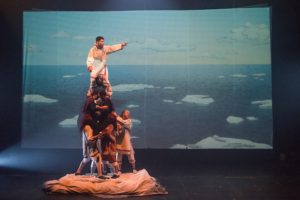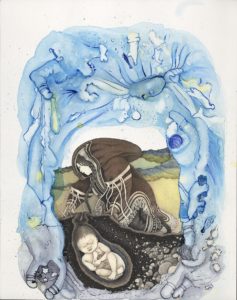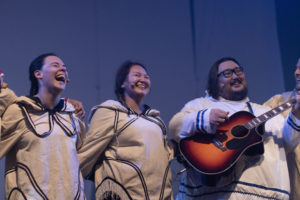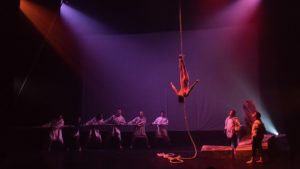Artcirq, The 7 Fingers and Taqqut Productions: Unikkaaqtuat - Vancouver Ballet Society
- Home
- Reviews 2020 - 2023
- Artcirq, The 7 Fingers and Taqqut Productions: Unikkaaqtuat

At the January premiere of Unikkaaqtuat at Ottawa’s National Arts Centre, we were welcomed by the NAC’s Indigenous Theatre artistic director Kevin Loring. He pointed out that we could expect to be puzzled: “Confusion is part of any cultural exchange, so please embrace it.”
Embracing this ambitious collaboration between Igloolik’s social circus collective Artcirq, Quebec’s The 7 Fingers and the Iqaluit-based media company Taqqut Productions was not at all hard to do. And despite the predominance of un-translated Inuktitut spoken throughout, I’m sure that most of us who, like me, don’t speak the language, were not confused by this visually rich multi-disciplinary production.

Based on origin myths of the far North, Unikkaaqtuat’s framework is a series of tableaux and enacted stories as imagined by a young man named Levy (performed by Levy Tapatsiak). Lying sick in a hospital bed, he listens to audiocassette tapes of his grandfather telling stories about the old ways (Unikkaaqtuat means “Old Stories” in Inuktitut).
The sickbed device allows the audience to dive into and out of ancient legends populated by animals and other elements from Inuit cosmology as if we, too, are in a fever dream, falling in and out of states of consciousness.
In one scene, a group of tumbler Rabbits lead a human hunter on a merry chase in the dark (at times through the auditorium); a stilt performer with long black hair and a mask dances Raven, his quick pecking movements bird-like. Later, a Polar Bear appears to menace the performers — and makes us laugh out loud at its realistic movement.

These vignettes sometimes morph in or out of familiar circus routines — human pyramid, acrobatics, aerial silks and feats of strength as cast members lift each other into the air. While performed with a sense of play (indeed many take the shape of games played among friends), traditional circus values do peek out during some of the routines. When Tapatsiak fails to execute the highest high kick in a traditional Inuit contest of agility and daring, everyone re-sets positions to let him try again. It’s a circus convention that you keep trying until you stick the trick.
Or, in the case of contortionist and virtuoso aerial silk artist Marjorie Nantel, her high-speed silks spins are performed largely without theatrical embellishment as a wonder in their own right.
Such pure circus moments are rare, however: a seamless integration of text, music, myth and playful athleticism is clearly the goal. Each discipline supports the others, with occasional juxtapositions that surprise and delight. Part of the same underwater scene that features Nantel also involves throat singers Christine Tootoo and Charlotte Qamaniq vocalizing while swinging upside down on silks.
In another scene, a hospital bed turns into an ice floe, and later a dog sled. Most audience members will be familiar with this imagery from the frozen North — as Canadians we grow up with it. But the idea that these performers all live or work extensively in Nunavut, often together, lends a sense of authenticity to the production. There’s humour, yet nothing feels caricatured. And that allows the audience to simply pursue curiosity and wonder. What a relief.
Stunt timing requirements aside, there’s a lovely looseness to Unikkaaqtuat’s parade of scenes and images. I found myself wondering if the show would be as charming if the trajectory were slicker or more propulsive, as it will almost certainly become as the project tours.
The large screen dominating the rear stage area does help with coherence, and animated projections based on the artwork of Inuit illustrator Germaine Arnaktauyok are an important part of the show. Arnaktauyok’s lyrical coloured drawings both separate and introduce concepts and scenes, adding visual punctuation to the foregrounded real life activity. One particularly effective section involves a live performer on ropes, a long braid, a drawing of a fetus attached to its mother by an umbilical cord and an animated narwhal with its textured horn. The metaphorical connections are easy to follow, even if we understand not a word of the narrated Inuktitut text.

There was a jarring note for me near the end, with the abrupt dismissal of the hospital bed conceit. Although earlier Levy had seemed very ill with stomach pain, at one point collapsing with plummeting vital signs, he has suddenly vanished from the hospital. Perhaps, as one doctor character puts it: “He just wanted to go hunting.” This point needs a more reasonable resolution or explanation.
In fact the last few scenes of the show are all a bit shaggy, and the bit featuring performer Charlie Gordon wielding a bullwhip as Tapatsiak shifts giant fake rocks around was weak. It felt almost as if the magic had run out and the creative team was struggling to wrap things up.
But then the production recovers with a gentle musical number, the cast standing in a row and singing, musician Joshua Qaumariaq strumming a guitar. It was a hauntingly beautiful melody, and a quiet moment of mutual summing up before the audience jumped to its feet.
— KATHLEEN SMITH

